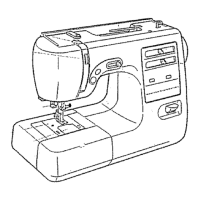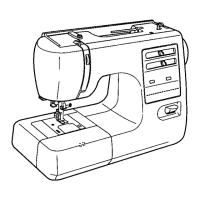
Do you have a question about the Kenmore 385.16130200 and is the answer not in the manual?
| Type | Mechanical |
|---|---|
| Model | 385.16130200 |
| Brand | Kenmore |
| Needle Type | Universal |
| Stitch Length | Adjustable |
| Speed Control | Yes |
| Automatic Needle Threader | No |
| Drop Feed | Yes |
| Free Arm | Yes |
| Foot Control | Yes |
| Bobbin Type | Class 15 |
| Presser Feet | Buttonhole, Button Sewing, Zipper |
| Included Accessories | Needles, Bobbins, Seam Ripper, Screwdriver |
Instructions to reduce the risk of electric shock.
Instructions to reduce risk of burns, fire, electric shock, or injury.
Covers mechanical defects for 25 years from purchase date.
Covers electrical/electronic defects for 2 years from purchase date.
Covers parts and mechanical service for 90 days from purchase date.
Information on the availability of cabinets and tote bags.
Identification of machine components via a detailed diagram.
Step-by-step guide for connecting the sewing machine to power.
Initial setup and preparation before the first use.
General safety precautions to follow during operation.
Explanation and safety considerations for the polarized plug.
How to adjust sewing speed using the foot control.
Use for straight and zigzag stitches.
Use exclusively for straight stitching.
For one-step automatic buttonholing.
For sewing zippers on either side.
For perfect blind hemming and topstitching.
Setup for winding thread onto the bobbin.
Using the extra spool pin for bobbin winding.
Instructions for using the automatic needle threader.
How to achieve balanced stitch tension for straight stitch.
Identifying and correcting tight needle thread tension.
Identifying and correcting loose needle thread tension.
Achieving balanced zigzag stitch tension.
Identifying and correcting tight zigzag tension.
Identifying and correcting loose zigzag tension.
Basic straight stitch operation and settings.
Technique for decorative topstitching.
Using the quilter for straight quilting lines.
Instructions for attaching the zipper foot.
Preparing fabric and zipper for sewing.
Step-by-step guide for sewing zippers.
Overview and uses of the zigzag stitch.
Technique for decorative satin stitching.
Creating invisible hems.
Strong, durable stitch for elasticity and strength.
Decorative topstitch for stretch fabrics.
Step-by-step guide for sewing automatic buttonholes.
Guide to buttonhole template styles and sizes.
Step-by-step instructions for sewing manual buttonholes.
Adjusting stitch density for manual buttonholes.
Instructions for changing the machine's light bulb.
Keeping the bobbin area clean for optimal performance.
Solutions for needle thread breakage.
Solutions for bobbin thread breakage.
Solutions for needle breakage.
Troubleshooting common causes of skipped stitches.
Causes and solutions for seam puckering.
Addressing issues with fabric feeding.
Basic troubleshooting for a non-operational machine.
Fixing distorted stitch patterns.
Diagnosing and resolving machine noise issues.











